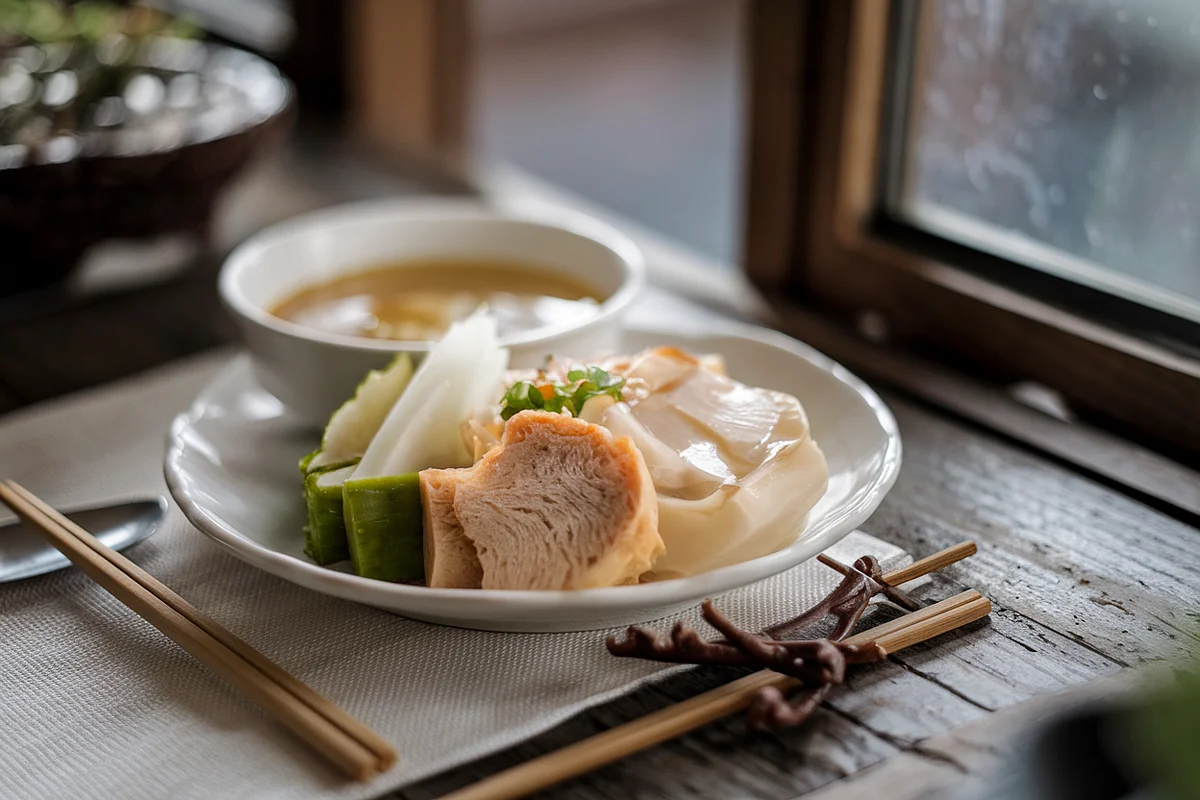Japanese cuisine is celebrated for its elegance, simplicity, and balance of flavors. Among the many elements that define this cuisine, soups play a vital role. Two of the most well-known Japanese soups are Japanese clear soup (suimono) and miso soup. While both are staples of Japanese dining, they differ significantly in ingredients, taste, texture, and their role in meals.
In this article, we’ll explore the key differences between clear soup and miso soup, from their ingredients to their health benefits and cultural significance. Whether you’re a fan of Japanese cuisine or new to these iconic dishes, this guide will provide you with everything you need to know.
A Delicate Beginning: What is Japanese Clear Soup?
Japanese clear soup is a light, delicate broth that’s often served as an appetizer or part of a formal multi-course meal. Its transparency and clarity make it an excellent palate cleanser. This soup is made primarily with dashi, a Japanese stock derived from kombu (dried kelp) and bonito flakes (fermented fish), offering subtle flavors that complement other dishes.
Simplicity in Every Sip: The Core Ingredients of Clear Soup
The ingredients in clear soup are minimal and designed to allow the natural flavors to take center stage. These include:
- Dashi broth (kombu and bonito flakes)
- Thinly sliced vegetables such as:
- Mushrooms
- Carrots
- Green onions
- Optional proteins such as:
- Fish
- Seafood
Unlike miso soup, clear soup doesn’t use thickening agents like miso paste. Its appeal lies in the clarity of the broth and the subtlety of its flavors, making it an ideal starter before heavier courses.
If you’re curious about how dashi forms the foundation of many Japanese soups, check out this comprehensive guide on Dashi Broth Basics.
A Hearty Favorite: What is Miso Soup?
Miso soup is among the most recognizable dishes in Japanese cuisine. Unlike clear soup, it is thicker and more flavorful, thanks to the addition of miso paste, made from fermented soybeans. This results in a savory, umami-rich broth with a cloudy appearance.
From Richness to Complexity: Miso Soup’s Key Ingredients
Miso soup typically includes:
- Dashi broth (as a base)
- Miso paste (made from fermented soybeans)
- Tofu
- Seaweed (often wakame)
- Green onions
The miso paste gives the soup a cloudy look and a deeply umami flavor, making it more filling than clear soup. For a deeper dive into the health benefits of miso, check out this Health Benefits of Miso guide.
A Journey Through History: The Evolution of Japanese Soups
Both Japanese clear soup and miso soup have long histories, deeply intertwined with the evolution of Japan’s culinary traditions. Each soup has played an important role in the cultural and ceremonial aspects of Japanese life.
The Role of Clear Soup in Formal Settings
For centuries, clear soups have been served during formal events, including tea ceremonies and multi-course meals (kaiseki). Its simplicity and purity are symbolic of refinement, often served as a palate cleanser between courses. The soup’s clarity and delicate flavors prepare the diner for stronger flavors in subsequent dishes.
The Household Staple: The Story of Miso Soup
Miso soup has been a staple in Japanese households for generations. The process of fermenting soybeans to make miso paste dates back over a thousand years, passed down through countless generations. Historically, everyone from farmers to samurai consumed miso soup due to its nutritional value and ease of preparation. Today, miso soup remains a crucial part of daily life in Japan.
Contrasting Flavors: Light and Subtle vs. Rich and Bold
The flavor profiles of clear soup and miso soup differ significantly, with each soup offering a unique experience based on its ingredients and preparation.
Clear Soup: A Subtle Symphony of Flavors
- Flavor: Japanese clear soup is light, delicate, and clean, offering a mild umami flavor from the dashi broth without overpowering the palate.
- Taste Profile: The soup allows the natural essence of the vegetables or seafood to shine, with each component maintaining its own distinct flavor.
Miso Soup: Packed with Umami
- Flavor: Miso soup is rich, savory, and packed with umami due to the fermented miso paste.
- Taste Profile: The fermentation process adds depth and complexity to the soup, making it heartier and more filling than clear soup.
The umami difference is especially noticeable, with miso soup providing a more robust flavor, while clear soup remains light and pairs well with other dishes in a multi-course meal.
Visual and Textural Contrasts: Clear vs. Cloudy
Not only do clear soup and miso soup differ in flavor, but they also present contrasting appearances and textures.
Transparency and Simplicity: The Appearance of Clear Soup
- Appearance: Japanese clear soup is completely transparent, with no floating particles or ingredients, showcasing the simplicity of the broth.
- Texture: The texture is light and watery, allowing it to be easily sipped without leaving a lingering aftertaste.
Rich and Thick: The Texture of Miso Soup
- Appearance: Miso soup has a cloudy appearance due to the dissolved miso paste. The tofu and seaweed make it visually more complex.
- Texture: The soup is slightly thicker than clear soup, thanks to the miso paste. The addition of tofu provides a silky texture, while seaweed offers a slight bite.
These differences are evident when the two soups are placed side by side. Clear soup is typically served in a small, shallow bowl, while miso soup comes in a deeper bowl with more visible ingredients.
When to Enjoy Each Soup: Occasion and Tradition
Each soup is served in different contexts, reflecting its role in Japanese meals and its cultural significance.
Clear Soup: A Formal Addition
- When: Clear soup is often served at formal events such as weddings, tea ceremonies, and multi-course meals (kaiseki).
- How: It is served in small portions to act as a palate cleanser, preparing diners for the next course without overwhelming their taste buds.
Miso Soup: A Daily Comfort
- When: Miso soup is a more casual dish, commonly served alongside everyday meals, including breakfast, lunch, and dinner.
- How: It is served in larger portions, often accompanied by other elements of a traditional Japanese meal, such as rice and pickled vegetables.
While clear soup is typically reserved for special events, miso soup is enjoyed daily by families across Japan as a versatile, nutritious dish.
Health Benefits of These Iconic Soups
Both clear soup and miso soup offer a variety of health benefits, though their nutritional content differs due to their ingredients.
Clear Soup: Light and Nutritious
- Low in Calories: Clear soup is primarily made of dashi broth and vegetables, making it very low in calories and ideal for those managing their weight.
- Hydration: The high water content helps with hydration and supports overall health.
- Gentle on Digestion: The simplicity of clear soup makes it easy to digest, which is why it is often served at the beginning of a meal.
Miso Soup: Rich in Nutrients
- Probiotics: The fermentation process in miso paste creates probiotics, which promote gut health.
- Rich in Vitamins and Minerals: Miso is a great source of essential nutrients, including vitamin K, manganese, zinc, and copper.
- Cardiovascular Health: Some studies suggest that regular consumption of miso soup may help lower blood pressure and improve heart health.
While miso soup contains more sodium, its nutritional benefits, such as probiotics and vitamins, make it a nutritious option for many.
Instant vs. Homemade: Convenience or Tradition?
In today’s busy world, both soups can be found in instant forms, offering quick and convenient ways to enjoy them. However, instant soups often fall short in terms of flavor and nutritional value.
Instant Clear Soup
- Availability: Less common in stores compared to instant miso soup, but it is available in some specialty markets.
- Flavor: Instant clear soup often lacks the depth and complexity of traditionally made dashi broth.
Instant Miso Soup
- Availability: Widely available in supermarkets and online stores.
- Flavor: While convenient, instant miso soup may not provide the same rich umami flavor or probiotics found in freshly made versions.
Traditional, homemade preparations of both soups offer superior taste and nutritional value, making them worth the extra time.
Frequently Asked Questions (FAQs)
What’s the Difference Between Japanese Onion Soup and Miso Soup?
Japanese onion soup is a type of clear soup made with dashi and onions, while miso soup uses miso paste, tofu, and seaweed. Onion soup has a milder and sweeter flavor, whereas miso soup is richer and full of umami.
Can You Substitute Clear Soup for Miso Soup?
Generally, no. The flavors and textures of clear soup and miso soup differ significantly, so substituting one for the other could alter the taste of the dish.
Are These Soups Vegetarian-Friendly?
Yes, both soups can be made vegetarian. Miso soup can use kombu dashi instead of bonito flakes, and clear soup can substitute vegetable broth in place of traditional dashi.
Conclusion: Choosing Between Clear Soup and Miso Soup
Both Japanese clear soup and miso soup hold important places in Japanese dining. Each offers distinct flavors, textures, and nutritional benefits, making them unique in their own right. Clear soup is perfect for formal dining occasions, while miso soup provides a heartier option for everyday meals.
By understanding the differences between these two soups, you can appreciate the depth and variety of Japanese cuisine. Whichever soup you choose, both deserve a place on your table, offering versatility, tradition, and flavor.



